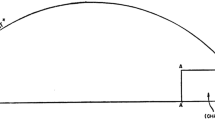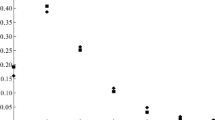Summary
The emission of Σ-hyperons from 3 037 K− capture stars at rest in nuclear emulsion has been studied. The identification of the hyperons is discussed. Charged Σ-hyperons are emitted from (17.6±1.0)% of all K−-stars while (9.6±0.6)% of them lead to the emission of both Σ-hyperons and π-mesons. The Σ−/Σ+ ratio for all stars is 0.86±0.12 while for stars in which a π-meson is also emitted it is 0.45±0.10. The difference between this latter value and the markedly different value (2.0) obtained for K−-interactions at rest in a hydrogen bubble chamber is attributed to the Fermi motion of nucleons in the nucleus, and a dependence of the relative K− transition amplitudes on the energy of relative motion of the K−-meson and nucleon. The branching ratio,R, of the number of Σ+ decays to π+ and proton respectively is 1.23±0.27. The stable prong distribution of the stars in which a hyperon is emitted, as well as the energy distribution of the Σ-hyperons at emission has been studied. About 16% of all identified charged Σ-hyperons had an emission energy above 60 MeV, and had to be attributed to multi-nucleon interactions of the K−-meson. It is estimated that the proportion of all multi-nucleon primary capture prccesses may be as high as (30÷40)%. The interaction of a K−-meson with a pair of neutrons seems to occur rarely, if at all. From the fraction of Σ+ emitting stars which also emit a π−-meson it is concluded that only about 10% of the π−-mesons fail to escape from the nucleus in which capture occurs. This could be understood if K−-capture occurs predominantly in the peripheral region of the nucleus. From a similar study of Σ− emitting stars it is found however that the proportion of π+ or π0-mesons, or both, that are absorbed in the nucleus is much higher. Estimates are made of the mean free path in nuclear matter of Σ-hyperons and π0-mesons. Most of the one-nucleon interactions leading to Σ-hyperon production take place with protons and the transition amplitudes corresponding to theT=1 state of isotopic spin is smaller than theT=0 transition amplitude.
Riassunto
È stata studiata l’emissione di 3 037 stelle di cattura K− a riposo in emulsione nucleare. Si discute l’identificazione degli iperoni. Il (17.6±1.0)% di tutte le stelle K− emette iperoni Σ carichi mentre il (9.6±0.6)% di esse emettono sia iperoni Σ che mesoni π. Il rapporto Σ−/Σ+ per tutte le stelle è 0.86±0.12, mentre che per le stelle che emettono anche un mesone π è 0.45±0.10. La differenza tra quest’ultimo valore e il valore nettamente differente (2.0) ottenuto per le interazioni K− a riposo in una camera a bolle a idrogeno si attribuisce al moto di Fermi dei nucleoni nel nucleo ed alla dipendenza delle ampiezze relative delle transizioni K− dall’energia del moto relativo del mesone K− e del nucleone. Il rapportoR del numero dei decadimenti Σ+ a quelli π+ e protonici rispettivamente è 1.23±0.27. È stata studiata la distribuzione dei rami stabili delle stelle in cui si emette un iperone, come pure la distribuzione dell’energia degli iperoni Σ all’emissione. Circa il 16% di tutti gli iperoni Σ carichi identificati avevano energia di emissione superiore a 60 MeV ed hanno dovuto essere attribuiti alle interazioni multinucleoniche del mesone K−. Si stima che la proporzione di tutti i processi multinucleonici primari di cattura raggiunga il (30÷40)%. L’interazione di un K− con una coppia di neutroni sembra occorrere, se mai, raramente. Dalla frazione di stelle che emettono Σ+ emettendo anche un mesone π− si conclude che solo circa il 10% dei mesoni π− non abbandonano il nucleo in cui la cattura avviene. Ciò sarebbe comprensibile se la cattura K− avvenisse prevalentemente nelle regioni periferiche del nucleo. Da un simile studio delle stelle che emettono dei Σ− si trova, tuttavia, che la proporzione dei mesoni π+ o π0, o delle due specie, assorbiti nel nucleo è molto maggiore. Si valuta il cammino libero medio degli iperoni Σ e dei mesoni π0 nella materia nucleare. La maggior parte delle interazioni di I nucleone che conducono alla produzione di iperoni Σ avvengono con protoni e le ampiezze di transizione corrispondenti allo statoT=1 dello spin isotopico sono minori dell’ampiezza di transizioneT=0.
Similar content being viewed by others
References
K − Collaboration:Nuovo Cimento,13, 690 (1959).
D. J. Prowse: collected by private communication.
M. C. Amerighi, M. Beniston, A. Bonetti, D. H. Davis, M. Di Corato, C. C. Dilworth, D. Ferreira, E. Frota-Pessoa, W. B. Lasich, N. N. Raina, M. René, J. Sacton andA. E. Sichirollo:Nuovo Cimento,12, 91 (1959).
R. H. Capps:Phys. Rev.,107, 239 (1957).
R. M. Frank, J. L. Gammel andK. M. Watson:Phys. Rev.,101, 891 (1956).
G. Bernardini andF. Lévy:Phys. Rev.,84, 610 (1952).
G. Ferrari, L. Ferretti, R. Gessaroli, E. Manaresi, E. Pedretti, G. Puppi, G. Quareni, A. Ranzi, A. Stanghellini andS. Stantic:Suppl. Nuovo Cimento,4, 914 (1956).
J. V. Major: private communication.
M. Shafi andD. J. Prowse:Padua-Venice Conference Report (1957), p. x-2.
L. W. Alvarez, H. Bradner, P. Falk-Vairant, J. D. Gow, A. H. Rosenfeld, F. T. Solmitz andR. D. Tripp:Nuovo Cimento,5, 1026 (1957).
Berkeley bubble chamber results, reported byM. F. Kaplon:Geneva Conference Report (1958), p. 176.
R. D. Tripp:Geneva Conference Report (1958), p. 185.
Y. Eisenberg, W. Koch, E. Lohrmann, E. Nikolić, M. Schneeberger andH. Winzeler:Nuovo Cimento,9, 745 (1958).
See contribution toKaplon’s Report, Geneva Conference (1958).
P. B. Jones:Phil. Mag.,3, 33 (1958).
D. G. Ravenhall:Rev. Mod. Phys.,30, 430 (1958).
C. Chedester, P. Isaacs, A. Sachs andJ. Steinberger:Phys. Rev.,82, 958 (1951);R. L. Martin:Phys. Rev.,87, 1052 (1952).
B. Rossi:High Energy Particles (New York, 1952), p. 359.
M. H. Johnson andE. Teller:Phys. Rev.,93, 357 (1954).
Note added in proof. — RecentlyWildermuth developed the «cluster-model» of the nucleus, giving arguments in favour of the clustering of nucleons at the periphery of nuclei (K. Wildermuth andTh. Kanellopoulos: CERN, Theor. Division (1959)).
W. Alles, N. N. Biswas, M. Ceccarelli andJ. Crussard:Nuovo Cimento,6, 517 (1957).
Author information
Authors and Affiliations
Additional information
On leave of absence from the University of Panjab, (in Part I,Nuovo Cimento,13, 690 (1959), it was mistakenly written Panjab, Pakistan).
Rights and permissions
About this article
Cite this article
Bhowmik, B., Evans, D., Falla, D. et al. The interaction of K−-mesons with photographic emulsion nuclei. Nuovo Cim 14, 315–364 (1959). https://doi.org/10.1007/BF02728320
Received:
Revised:
Published:
Issue Date:
DOI: https://doi.org/10.1007/BF02728320




